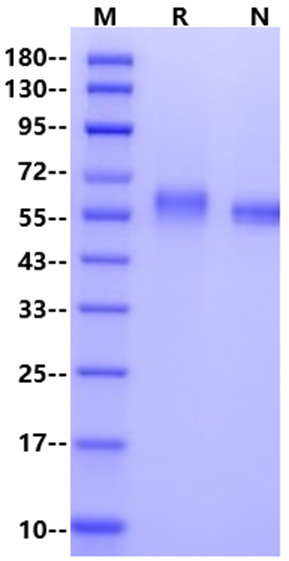Asp25-Ser424, with C-terminal 8*His DRLDCVKASDQCLKEQSCSTKYRTLRQCVAGKETNFSLASGLEAKDECRSAMEALKQKSLYNCRCKRGMKKEKNCLRIYWSMYQSLQGNDLLEDSPYEPVNSRLSDIFRVVPFISVEHIPKGNNCLDAAKACNLDDICKKYRSAYITPCTTSVSNDVCNRRKCHKALRQFFDKVPAKHSYGMLFCSCRDIACTERRRQTIVPVCSYEEREKPNCLNLQDSCKTNYICRSRLADFFTNCQPESRSVSSCLKENYADCLLAYSGLIGTVMTPNYIDSSSLSVAPWCDCSNSGNDLEECLKFLNFFKDNTCLKNAIQAFGNGSDVTVWQPAFPVQTTTATTTTALRVKNKPLGPAGSENEIPTHVLPPCANLQAQKLKSNVSGNTHLCISNGNYEKEGLGASSGGGSHHHHHHHH
55-70kDa
Reconstitute at 0.1-1 mg/ml according to the size in ultrapure water after rapid centrifugation.
1. Mihwa Kim. GFRA1: A Novel Molecular Target for the Prevention of Osteosarcoma Chemoresistance. Int J Mol Sci. 2018 Apr 4;19(4):1078.
The glycosylphosphatidylinositol-linked GDNF (glial cell derived neurotrophic factor) receptor alpha (GFRA), a coreceptor that recognizes the GDNF family of ligands, has a crucial role in the development and maintenance of the nervous system. Of the four identified GFRA isoforms, GFRA1 specifically recognizes GDNF and is involved in the regulation of proliferation, differentiation, and migration of neuronal cells. GFRA1 has also been implicated in cancer cell progression and metastasis. Recent findings show that GFRA1 can contribute to the development of chemoresistance in osteosarcoma. GFRA1 expression was induced following treatment of osteosarcoma cells with the popular anticancer drug, cisplatin and induction of GFRA1 expression significantly suppressed apoptosis mediated by cisplatin in osteosarcoma cells. GFRA1 expression promotes autophagy by activating the SRC-AMPK signaling axis following cisplatin treatment, resulting in enhanced osteosarcoma cell survival. GFRA1-induced autophagy promoted tumor growth in mouse xenograft models, suggesting a novel function of GFRA1 in osteosarcoma chemoresistance.

1μg (R: reducing condition, N: non-reducing condition).

Immobilized GDNF Protein, Human (Cat. No. UA040211) at 0.5μg/mL (100μL/well) can bind GFRA1 His Tag Protein, Human (Cat. No. UA010524) with EC50 of 6.16-10.92ng/mL.